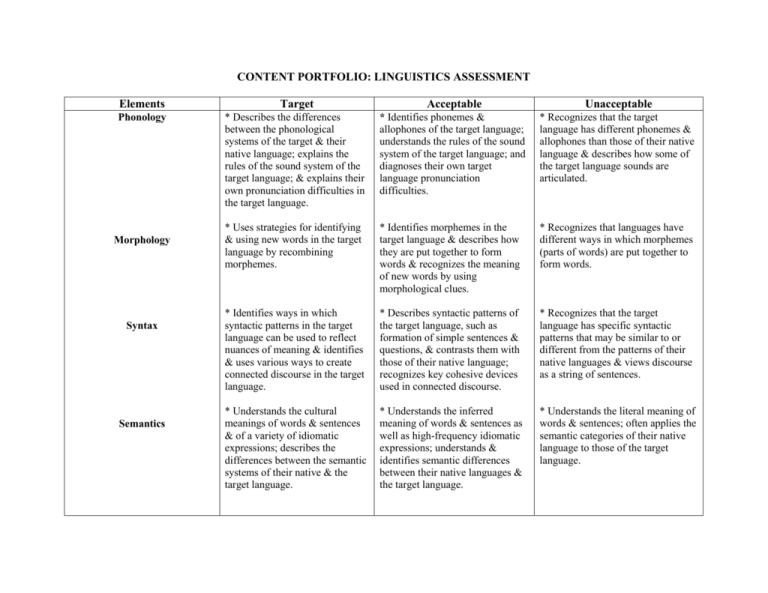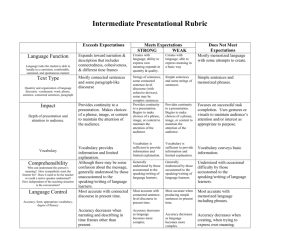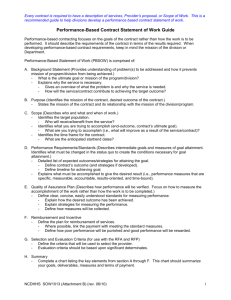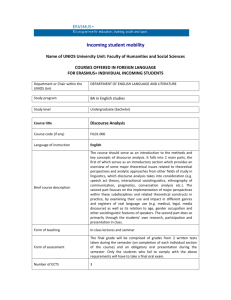CONTENT PORTFOLIO: LINGUISTICS ASSESSMENT
advertisement

CONTENT PORTFOLIO: LINGUISTICS ASSESSMENT Elements Target Acceptable Unacceptable Phonology * Describes the differences between the phonological systems of the target & their native language; explains the rules of the sound system of the target language; & explains their own pronunciation difficulties in the target language. * Identifies phonemes & allophones of the target language; understands the rules of the sound system of the target language; and diagnoses their own target language pronunciation difficulties. * Recognizes that the target language has different phonemes & allophones than those of their native language & describes how some of the target language sounds are articulated. * Uses strategies for identifying & using new words in the target language by recombining morphemes. * Identifies morphemes in the target language & describes how they are put together to form words & recognizes the meaning of new words by using morphological clues. * Recognizes that languages have different ways in which morphemes (parts of words) are put together to form words. * Identifies ways in which syntactic patterns in the target language can be used to reflect nuances of meaning & identifies & uses various ways to create connected discourse in the target language. * Describes syntactic patterns of the target language, such as formation of simple sentences & questions, & contrasts them with those of their native language; recognizes key cohesive devices used in connected discourse. * Recognizes that the target language has specific syntactic patterns that may be similar to or different from the patterns of their native languages & views discourse as a string of sentences. * Understands the cultural meanings of words & sentences & of a variety of idiomatic expressions; describes the differences between the semantic systems of their native & the target language. * Understands the inferred meaning of words & sentences as well as high-frequency idiomatic expressions; understands & identifies semantic differences between their native languages & the target language. * Understands the literal meaning of words & sentences; often applies the semantic categories of their native language to those of the target language. Morphology Syntax Semantics Rules for word & Sentence formation * Describes in detail the rules that govern the formation of words & sentences in the target language & compares them with their native language. * Explains the rules that govern the formation of words & sentences in terms of regularities & irregularities & provides target language examples of these rules. * Recognizes that the target language has a set of rules that govern the formation of words & sentences & identifies key regularities. * Explains how word and sentence formation can be used to express nuances of meaning. Discourse, sociolinguistic, & pragmatic knowledge * Explains pragmatic & sociolinguistic features of target language discourse and how these features convey contextual & cultural meaning & how they vary based on setting, goal of communication, & participants. * Explains target language features for creating coherence in extended spoken & printed texts. * Identifies the pragmatic & sociolinguistic features of target language discourse. * Identifies target language features for creating coherence in extended spoken & printed texts. * Demonstrates awareness of the pragmatic & sociolinguistic features of target language discourse & of target language features for creating coherence in extended spoken & printed texts. Changing nature of language * Describes the system of changes that have occurred in the target language over time; demonstrates familiarity with contemporary target language usage & adapts the language of their instructional materials accordingly. * Identifies key changes in the target language that have occurred over time as well as discrepancies that may exist between the target language of their instructional materials & contemporary usage. * Recognizes that the target language changes over time; relies on target language examples as presented in their instructional materials. Dispositions for accommodating for gaps in knowledge of the target language * Takes courses or seeks help to accommodate for gaps in knowledge of the target language system. * Investigates the target language system & examples on their own when faced with specific aspects of the system with which they are unfamiliar. * Asks questions when lacking knowledge of specific aspects of the target language system.









